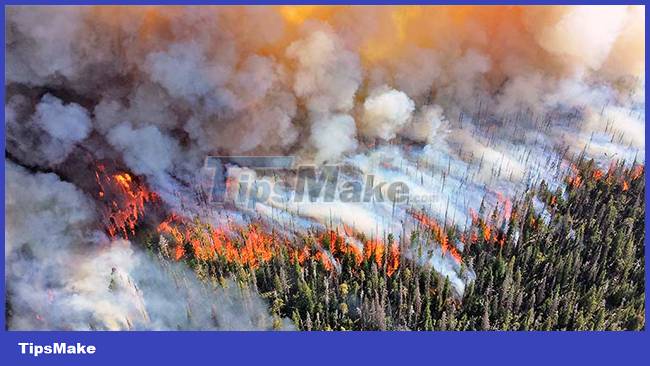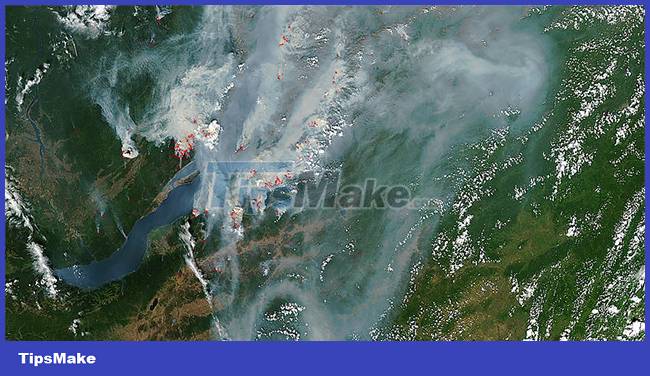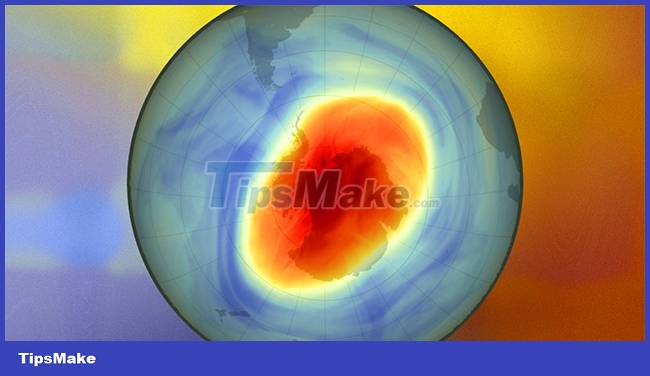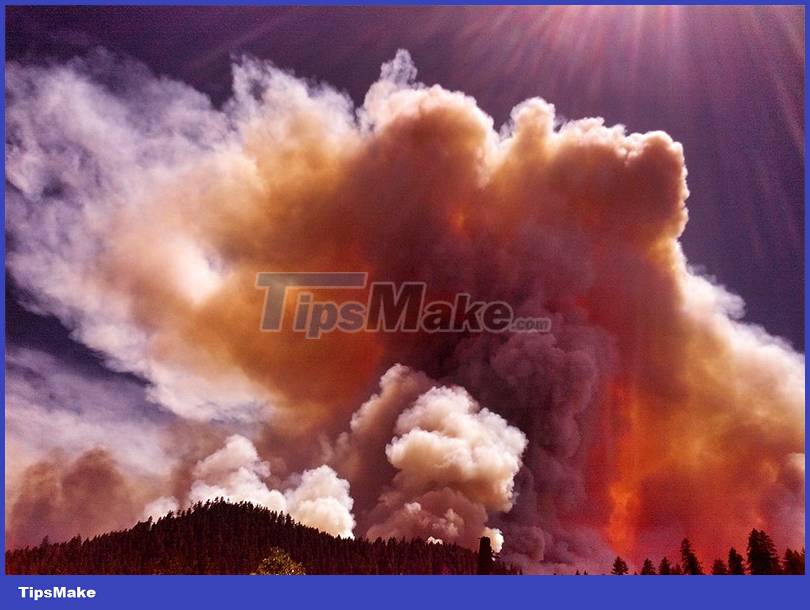How do wildfires affect Earth's ozone layer?
Towering plumes of smoke brought into the stratosphere by raging wildfires could eat away at Earth's ozone layer thanks to a powerful combination of smoke, gas chemistry, a new study suggests. atmosphere and ultraviolet rays.
In late 2019 and early 2020, Australia's skies turned black, darkened by thick columns of bushfire smoke reaching into the stratosphere. Later, satellite data revealed that smoke from wildfires somehow reacted with molecules in the atmosphere to eat away at Earth's ozone layer. But exactly how it happened is unknown.

Now, scientists have put the pieces of those chemistry puzzles together. Once in the stratosphere, smoke particles can interact with stratospheric gases as well as the prolonged release of ozone-depleting chemicals, the team says. Add in solar radiation, and that smoke produces chlorine radicals, a chemical capable of attacking and destroying the ozone layer, the researchers report in the March 9 issue of the journal Nature.
These events, the researchers estimate, create a chain that is responsible for about 3 to 5 percent of the ozone layer depletion in parts of the Southern Hemisphere in 2020. That's just a fraction of the total. things that affect the ozone layer — but it's on par with the scale of the impact of human emissions of chlorofluorocarbons that corroded the ozone layer in their heyday, says atmospheric chemist Susan Solomon of MIT.
Chlorofluorocarbons were once used in air conditioners and refrigerators, but their release into the atmosphere has resulted in a large hole over Antarctica in Earth's protective ozone layer, limiting the amount of radiation The sun's ultraviolet radiation reaches the planet's surface.
In the new study, Solomon and her colleagues compared atmospheric observations of chlorine, ozone and other molecules following the Australian bushfires with simulations of atmospheric chemistry. The satellites have measured the levels of several chemicals in the stratosphere by 2020 - not only the ozone layer but also hydrogen chloride and chlorine nitrate among others. Those levels caught Solomon's attention.

'What we see in Australia is a significant drop in hydrogen chloride' in the satellite data, she said. 'I think this place looks like Antarctica. How can this happen across Australia?'
Hydrogen chloride gas is a product of the decomposition of chlorofluorocarbons, which can persist for decades in the stratosphere. Antarctica's frigid environment is an important part of the formation of the ozone hole, because Antarctic temperatures can cause hydrogen chloride gas to dissolve into icy clouds and move to the stratosphere. . Absorbing that gas is essential to starting the chain reaction that forms ozone-depleting chemicals.
The atmosphere in Australia is too warm for this process - but satellite data indicates that something is still removing hydrogen chloride from the atmosphere. Solomon and her team found that the culprits were organic particles in the smoke. Those particles can absorb hydrogen chloride gas even at warmer temperatures, which is the inevitable start to this chain of events.

With hydrogen chloride absorbed, smoke particles can act as catalysts, helping to speed up other reactions in the atmosphere. In particular, these particles promote the conversion of other chlorinated gases floating in the stratosphere, such as chlorine nitrate and hypochlorous acid, which can turn into potentially reactive chlorine compounds. high with the light of the sun.
Mixing the sun's ultraviolet radiation with those new chlorine compounds creates chlorine radicals, free molecules that are extremely chemically reactive — and especially love to attack molecules in the air. ozone layer.
The discovery of this wildfire-related ozone depletion process is a potentially worrisome obstacle to ozone recovery, says Solomon. The 1987 Montreal Protocol targeted the use of chlorofluorocarbons, which were phased out in 2010, which was successful and encouraging in closing the Antarctic ozone hole. The ozone layer has shown signs of recovery since then, growing back on the order of 1% per decade, she said.

However, smoke from the Australian bushfires more or less 'wiped out all those jobs' for the year, Solomon added.
Climate change is expected to increase the intensity and frequency of wildfires globally, sending more towering fire clouds soaring into the sky. 'If these fires are a one-off, it might not be so bad' for ozone layer recovery, says Solomon. 'But if it happens every five years, that's a different story.'
Ross Salawitch, an atmospheric chemist at the University of Maryland in College Park who was not involved in the study, said the study explains some of the satellite observations that occurred after the fires in Australia. It sheds light on the drop in hydrogen chloride, as well as unusual increases in other chlorine compounds such as chlorine nitrate and chlorine oxide, he said.
But most importantly, Salawitch says uncovering the role of organic particles can improve our understanding of what controls the size of the ozone hole. "This is important not only because we want to know the exact details, but also because 'one of the unfortunate consequences of global warming could be an increase in the frequency and extent of this,'" he said. the severity of the wildfires.'
You should read it
- The ozone layer has just appeared a new concern
- Mini ozone hole opens over Arctic and, yes, that's kinda weird
- Interesting finding: Forest trees have thicker shells where fire often occurs
- Scientists conducted an expedition to explore an ancient forest of 60 thousand years old
- 10 survival skills for lost forest goers
- How to Use the Productivity App Forest
- Smoke - The killer killed invisible in fires
- Where to find a flashlight in Sons of the Forest
May be interested
- Configuring play Layer Of Fear on computer
 you can choose to configure it to a high or low graphics level to experience the layer of fear 2 in this article.
you can choose to configure it to a high or low graphics level to experience the layer of fear 2 in this article. - Historical events occurring on March 15 'gloomy' make many people abstain
 historically, there are many scary events happening on march 15 that many people are afraid of war, epidemic, natural disasters ... is it a coincidence or a hidden mystery? somehow.
historically, there are many scary events happening on march 15 that many people are afraid of war, epidemic, natural disasters ... is it a coincidence or a hidden mystery? somehow. - 11 interesting differences between the two ends of the Earth: Arctic and Antarctica
 because of the tilt of the earth's rotation axis, the amount of sunlight that reaches the arctic and antarctica is quite the opposite, so everything exists and happens at two different poles.
because of the tilt of the earth's rotation axis, the amount of sunlight that reaches the arctic and antarctica is quite the opposite, so everything exists and happens at two different poles. - How to Burn Dual Layer DVD
 a dual layer dvd (digital versatile disc) is similar to the original dvd created by efmplus in 1995 except it can store up to 8.5 gigabytes of data instead of just 4.7 gigabytes. since a dual layer dvd has a different storage capacity you...
a dual layer dvd (digital versatile disc) is similar to the original dvd created by efmplus in 1995 except it can store up to 8.5 gigabytes of data instead of just 4.7 gigabytes. since a dual layer dvd has a different storage capacity you... - How to rotate a layer in Photoshop
 how to rotate a layer in photoshop. rotating the layer is a fairly basic operation in photoshop, it is similar to when we rotate an image. in this article, tipsmake.com will show you how to rotate a layer in photoshop, please follow along.
how to rotate a layer in photoshop. rotating the layer is a fairly basic operation in photoshop, it is similar to when we rotate an image. in this article, tipsmake.com will show you how to rotate a layer in photoshop, please follow along. - How to enable 2-layer authentication on Zalo
 zalo now provides 2-layer authentication feature on zalo, to increase the security of your personal account when logging into your zalo account on an unfamiliar device.
zalo now provides 2-layer authentication feature on zalo, to increase the security of your personal account when logging into your zalo account on an unfamiliar device. - Hardware in OSI reference model: Layer 2
 in the previous part of this series, we have introduced the 7-layer osi reference model and the first layer, which is the physical layer. in the second part of this series, we will introduce the second layer, the data link layer or data link, from a hardware perspective.
in the previous part of this series, we have introduced the 7-layer osi reference model and the first layer, which is the physical layer. in the second part of this series, we will introduce the second layer, the data link layer or data link, from a hardware perspective. - What are Application Layer Attacks? What to do when attacked at the application layer?
 application layer attacks are a type of distributed denial of service (ddos) attack that is a type of cyber attack that targets the top layer in the osi model, where protocols like http get and http post operate.
application layer attacks are a type of distributed denial of service (ddos) attack that is a type of cyber attack that targets the top layer in the osi model, where protocols like http get and http post operate. - How is the structure of 2-layer, 3-layer, 4-layer and 5-layer medical masks different?
 structure of medical masks 2 - 3 - 4 - 5 layers are no different? let tipsmake.com find out!
structure of medical masks 2 - 3 - 4 - 5 layers are no different? let tipsmake.com find out! - Instructions for setting up 2-layer protection for Outlook accounts and Microsoft accounts
 microsoft provides users with 3 options to set up 2-layer protection. you can use your email address, phone number or use the authenticator application to set up 2-layer protection for your outlook and microsoft accounts.
microsoft provides users with 3 options to set up 2-layer protection. you can use your email address, phone number or use the authenticator application to set up 2-layer protection for your outlook and microsoft accounts.










 Rhodium - The most expensive metal in the world is 5 times more expensive than gold
Rhodium - The most expensive metal in the world is 5 times more expensive than gold How to read and write files using JES application
How to read and write files using JES application The 'mirror super power plant' from 12,000 giant mirrors produces electricity even at night
The 'mirror super power plant' from 12,000 giant mirrors produces electricity even at night Today, the solar storm will 'directly hit' the earth
Today, the solar storm will 'directly hit' the earth Explore Glory Hole, a man-made 'monster' hole
Explore Glory Hole, a man-made 'monster' hole Surprising facts about aircraft tires not everyone knows
Surprising facts about aircraft tires not everyone knows